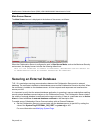
RealPresence Collaboration Server (RMX) 1500/1800/2000/4000 Administrator’s Guide
Polycom®, Inc. 833
For a full description of this procedure see the Polycom® RealPresence® Collaboration Server (RMX®)
1500/2000/4000 Deployment Guide for Maximum Security Environments, Restoring the RMX Using the
USB Port .
MLPP (Multi Level Precedence and Preemption)
In compliance with UC APL requirements, Quality of Service (QoS) can be more accurately modified to
suit local needs with the addition of Multi Level Precedence and Preemption methods for call prioritizing
and call handling.
QoS is important when transmitting high bandwidth audio and video information. QoS can be measured and
guaranteed in terms of:
● Latency
● Low packet throughput
● Average delay between packets
● Jitter (variation in delay)
● Transmission error rate
● Order of packet delivery
Precedence is the method by which a call is assigned a priority level. The RMX supports two separately
defined and configurable Domains, each having its own Precedence policy.
For a full description of Precedence see IETF RFC 2474.
One of the following Precedence Levels is assigned to all calls:
Conferences can have a mix of participants from different Precedence domains and network domains.
Precedence is supported for both IPv4 and IPv6.
Preemption is the method whereby, when system resources are insufficient, lower priority calls are
terminated and their resources assigned to higher priority calls. Preemption is typically a function of
network components such as the Local Session Controller (LSC). To the RMX, a preempted call appears
as a disconnected call.
Precedence Levels
Highest Priority
FLASH-OVERRIDE-OVERRIDE (Classified Networks only)
FLASH-OVERRIDE
FLASH
IMMEDIATE
PRIORITY
Lowest Priority
ROUTINE


















